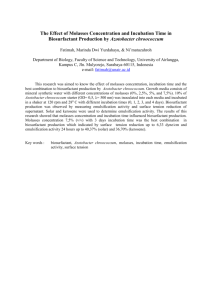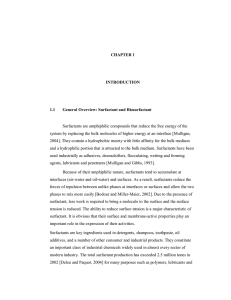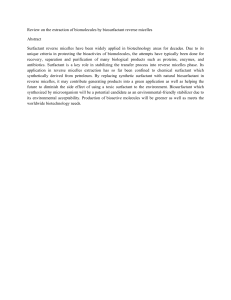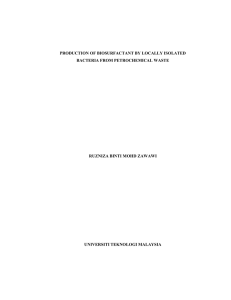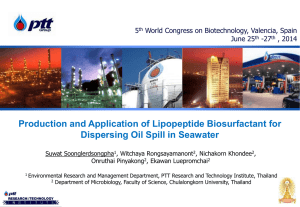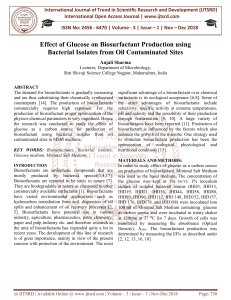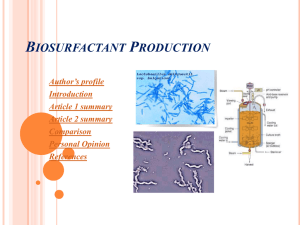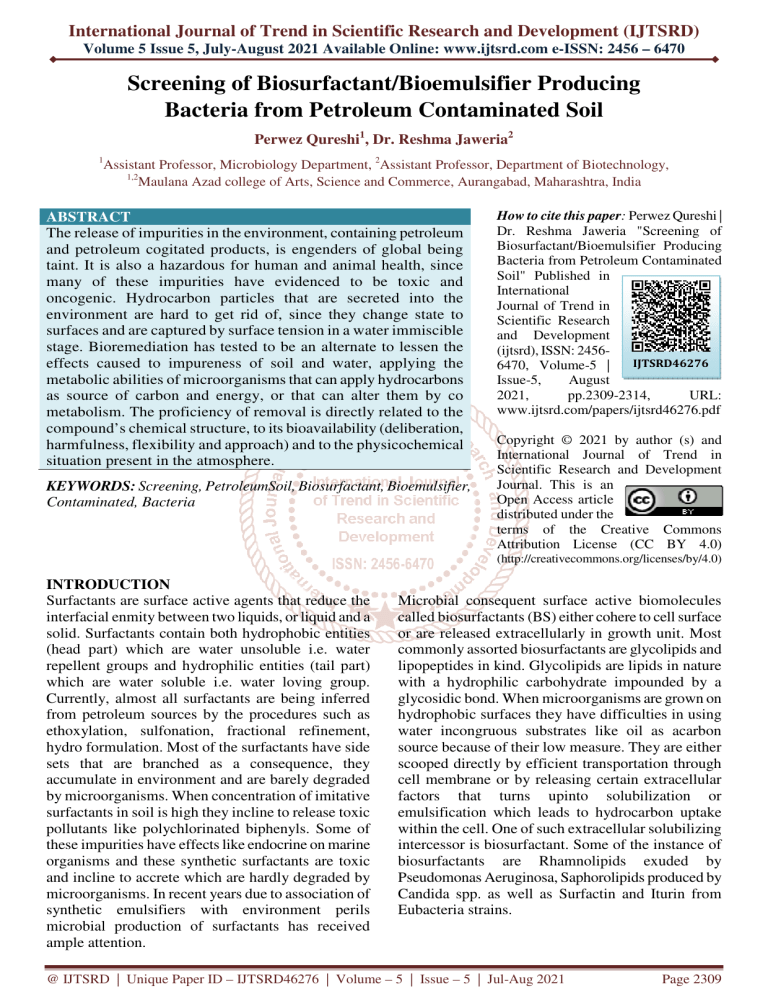
International Journal of Trend in Scientific Research and Development (IJTSRD)
Volume 5 Issue 5, July-August 2021 Available Online: www.ijtsrd.com e-ISSN: 2456 – 6470
Screening of Biosurfactant/Bioemulsifier Producing
Bacteria from Petroleum Contaminated Soil
Perwez Qureshi1, Dr. Reshma Jaweria2
1
Assistant Professor, Microbiology Department, 2Assistant Professor, Department of Biotechnology,
1,2
Maulana Azad college of Arts, Science and Commerce, Aurangabad, Maharashtra, India
ABSTRACT
The release of impurities in the environment, containing petroleum
and petroleum cogitated products, is engenders of global being
taint. It is also a hazardous for human and animal health, since
many of these impurities have evidenced to be toxic and
oncogenic. Hydrocarbon particles that are secreted into the
environment are hard to get rid of, since they change state to
surfaces and are captured by surface tension in a water immiscible
stage. Bioremediation has tested to be an alternate to lessen the
effects caused to impureness of soil and water, applying the
metabolic abilities of microorganisms that can apply hydrocarbons
as source of carbon and energy, or that can alter them by co
metabolism. The proficiency of removal is directly related to the
compound’s chemical structure, to its bioavailability (deliberation,
harmfulness, flexibility and approach) and to the physicochemical
situation present in the atmosphere.
KEYWORDS: Screening, PetroleumSoil, Biosurfactant, Bioemulsifier,
Contaminated, Bacteria
How to cite this paper: Perwez Qureshi |
Dr. Reshma Jaweria "Screening of
Biosurfactant/Bioemulsifier Producing
Bacteria from Petroleum Contaminated
Soil" Published in
International
Journal of Trend in
Scientific Research
and Development
(ijtsrd), ISSN: 2456IJTSRD46276
6470, Volume-5 |
Issue-5,
August
2021,
pp.2309-2314,
URL:
www.ijtsrd.com/papers/ijtsrd46276.pdf
Copyright © 2021 by author (s) and
International Journal of Trend in
Scientific Research and Development
Journal. This is an
Open Access article
distributed under the
terms of the Creative Commons
Attribution License (CC BY 4.0)
(http://creativecommons.org/licenses/by/4.0)
INTRODUCTION
Surfactants are surface active agents that reduce the
interfacial enmity between two liquids, or liquid and a
solid. Surfactants contain both hydrophobic entities
(head part) which are water unsoluble i.e. water
repellent groups and hydrophilic entities (tail part)
which are water soluble i.e. water loving group.
Currently, almost all surfactants are being inferred
from petroleum sources by the procedures such as
ethoxylation, sulfonation, fractional refinement,
hydro formulation. Most of the surfactants have side
sets that are branched as a consequence, they
accumulate in environment and are barely degraded
by microorganisms. When concentration of imitative
surfactants in soil is high they incline to release toxic
pollutants like polychlorinated biphenyls. Some of
these impurities have effects like endocrine on marine
organisms and these synthetic surfactants are toxic
and incline to accrete which are hardly degraded by
microorganisms. In recent years due to association of
synthetic emulsifiers with environment perils
microbial production of surfactants has received
ample attention.
Microbial consequent surface active biomolecules
called biosurfactants (BS) either cohere to cell surface
or are released extracellularly in growth unit. Most
commonly assorted biosurfactants are glycolipids and
lipopeptides in kind. Glycolipids are lipids in nature
with a hydrophilic carbohydrate impounded by a
glycosidic bond. When microorganisms are grown on
hydrophobic surfaces they have difficulties in using
water incongruous substrates like oil as acarbon
source because of their low measure. They are either
scooped directly by efficient transportation through
cell membrane or by releasing certain extracellular
factors that turns upinto solubilization or
emulsification which leads to hydrocarbon uptake
within the cell. One of such extracellular solubilizing
intercessor is biosurfactant. Some of the instance of
biosurfactants are Rhamnolipids exuded by
Pseudomonas Aeruginosa, Saphorolipids produced by
Candida spp. as well as Surfactin and Iturin from
Eubacteria strains.
@ IJTSRD | Unique Paper ID – IJTSRD46276 | Volume – 5 | Issue – 5 | Jul-Aug 2021
Page 2309
International Journal of Trend in Scientific Research and Development @ www.ijtsrd.com eISSN: 2456-6470
Microbial surfactants are anatomically different group
of surface-active combinations produced by variety of
microorganisms and are getting considerable attention
due to their peculiar properties. Biosurfactants has
useful properties when compared to their chemically
synthesized similitudes such as biodegradability, low
toxicityconcerning humans, easy availability of raw
materials for production, stability over various range
of physical factors (Temperature, pH, ionic intensity),
deduction in surface tension and interface activity,
biocompatibility and edibility.
Majorly, biosurfactants were considered only as
hydrocarbon solvents but now their applications have
been greatly extended to replace chemical surfactants
such as carboxylates, sulphonates also sulphate acid
esters especially in oil, pharmaceutical and food
industry. Currently, biosurfactants have great market
requirement but these biomolecules do not contend
economically with synthetic equivalents because of
their higher creation cost. Aim of this study was to
classify potent biosurfactant producing bacteria from
petroleum contaminated soil samples for the making
of biosurfactant at industrial level.
Materials and Techniques
Biosurfactant producing bacteria
Sample collection:
Four different bacterial samples used in this study
were obscure from soil samples.
Enrichment and isolation of bacterial colonies:
1% (w/v) of each soil samples were inserted in 100ml
of Mineral Salt Medium (MSM) [KH2PO4 1.0 g/L,
MgSO4.7H2O 0.5 g/L, NaNO3 1.5g/L, CaCl2
0.02g/L, MnSO4 1.5g/L, FeSO4 0.01 g/L and
(NH4)2SO4 1.5g/L] with 1% (v/v) sunflower oil. All
the flasks were concealed at 30°C for 7 day.
Estrangement was done on MSM agar plate bearing
1% sunflower oil. After 2 days of cultivation
morphologically distinct clusters were selected. They
were gram varnished and used for further studies.
Screening for biosurfactant creation
Isolated clusters were obtained in sample and tested
for their biosurfactant production by the following
methods:
Qualitative methods
A. Blood hemolysis test
Bacterial cultures were spot enclosed on to
superimposed blood agar (SIBA) plates and fostered
at 30oC for 48hrs. The plates were visually remarked
for hemolysis around the settlement. The diameter of
the purestructure was recorded. It is a qualitative
signal of biosurfactant production.
B. Oil displacement assay and Emulsification
assay
100 ml of MSM stockholding sunflower oil 1% (v/v)
was inoculated with 1% substance (0.08 OD at
540nm) of the isolates showing β hemolysis and
incubated at 30oC at 200rpm for 7 days. After
incubation stock was moved at 8000rpm at 4oC for
15 minutes. Supernatant was utilized for following
screening procedures:
Oil displacement assay
20ml of water was kept inPetri dish and 20µl of
sunflower oil was supplemented the surface of the
water. 10µl of cell free cultivation victuals was then
added to the oil surface. Contiguous oil displacement
is the indicator of biosurfactant creation. Distilled
water and Tween-20 were used as negative and
positive controlsseverally.
Emulsification assay
1ml of cell free culture victuals was added to 5ml of
50mM-Tris buffer at pH 7. 2ml of sunflower oil was
added to this mixture and stream for 2 mins and
nurtured at room temperature for 24 hrs.
Emulsification
was
evaluated
as
E24
(emulsificationafter 24hrs).
Distilled water and Tween-20 were used as negative
and positive ensures severally.
C. CTAB agar plate method
This is semi valued assay to detect creation of anionic
biosurfactant. CTAB agar plate were inclined by
appending N, N, N-trimethyl ammonium
bromide(0.5mg/ml) and plain dye methylene blue
(0.2mg/ml) in MSM with 2% glycerol as a carbon
foundation. Cultures were pointenclosed on CTAB
agar plates at 30oC for 4-5 days. If an anionic
biosurfactant isreleased by microbes producing on the
plate they form ion match with CTAB and methylene
blue yielding dark blue halos. Which can be detected
under UV trans illuminator.
D. Foaming activity
Assorts were enclosed in nutrient stock and incubated
at 30oC at 200rpm for 72 hrs. Foam produced in
enclosed nutrient stock after 72hrs can be used as an
indicator for constituent production of biosurfactant
even in the deficiency of hydrophobic substrate.
Quantitative method
Measurement of surface tension
100ml of MSM stockincluding sunflower oil 1% (v/v)
was enclosed with 1% substance (0.08 OD at 540nm)
@ IJTSRD | Unique Paper ID – IJTSRD46276 | Volume – 5 | Issue – 5 | Jul-Aug 2021
Page 2310
International Journal of Trend in Scientific Research and Development @ www.ijtsrd.com eISSN: 2456-6470
of insulates showing β hemolysis and altered at 30oC
at 200rpm for 7 days. After incubation, stock was
centrifuged at 8000rpm at 4oC for 15 mins. Surface
tension of supernatant was evaluated by surface
tensiometer based on Wilhemy principle and matched
with uninoculatedstock. The results were conveyed in
mill newton per meter (mN/m). The surface activity
of the biosurfactant was denoted in terms of
percentage fall in surface tension which was
calculated by the subsequent formula,
Percentage of the reduction in Surface tension
(%)
ɣm = surface tension of uninoculated control
component and
ɣc = surface tension of measurement supernatant
Identification of Potent Biosurfactant Producer
Discrimination showing highest action was identified
settled on 16srRNA analysis. Gene sequencing was
executed at Metropolis, India to recognize the isolate.
Genomic DNA was educed from isolated bacterial
settlement by using commercial kit. PCR was carried
out utilizing the universal primers such as XB4 (10
pm/ µl) and PSL (10 pm/ µl). 2X KAPA Mix included
KAPA Taq DNA polymerase (1U/50 µl), KAPA Taq
cache, dNTPs (0.2 mm of each dNTP at 1X), MgCl2
(1.5 mm at 1X) and Preservative 3 µl of extracted
DNA and HPLC rank water. ProFlex PCR
arrangement was used for PCR with the following
cycle sequence, 30 cycles of 95 ºC for 30
seconds,95ºC for 5 minutes, 60 ºC for 30 seconds, 72
ºC for 45 seconds and final elongation was carried out
at 72 ºC for 7 minutes and sample was detained at
4ºC. Total volume of reaction substance contained5X
Sequencing buffer 1.75 µl, HPLC mark water, primer
XB4 (3.33 pm/ µl),Big Dye Terminator
v3.1(Sequencing RR mix) 0.5 µl, PCR product 0.3 µl
(3-5ng).Total substance volume was impacted to
sequencing PCR, which comprised of stage 1, 96ºC
for 3 minutes, 25 cycles of stage 2 - 96ºC for 10
seconds, 50º C for 5 seconds, 60ºC for 1 minute and
finally held at 4ºC.
Finally the product was laden on sequence-3500DX
Genetic unit for Sanger sequencing and so DNA
sequence was linked with NCBI GenBank entries by
applying BLAST algorithm.
Results and Discussions
39 different oil degrading bacterial assorts were
isolated from soil tainted with hydrocarbon. All the
classified strains were then examined for their ability
to make biosurfactant. Biosurfactant evolving strain
of Pseudomonas aeruginosa MTCC 7925 was utilized
as a positive mechanism. More than one examining
procedures were applied for studying the manufacture
of biosurfactant by assorts.
Out of 39 isolated values 14 were detected gram
positive and 25 were detected gram negative. As
shown in in table 1, 12 strains examined positive for β
hemolysis. In this study hemolytic attribute was used
as a primary measure for biosurfactant production
because biosurfactant being surfactant in nature
induces form change in RBC’s resulting in lysis
which can be found as a zone of clearance over the
colony. The chemical action of biosurfactants was
firstset off by Avigad and Bernheimer who detectedh
emolysis of RBC’s by biosurfactant made by B.
subtilis. Carrillo et al invented blood agar lysis as a
primary technique to examine of biosurfactant
production. None of the studies in the profession
reported non hemolytic attribute of biosurfactant.
However, hemolysis does not perpetually mean
biosurfactant production chemicals other than
biosurfactants may induce hemolysis.
Hence in the present study in accumulation to
hemolysis test, oil transposition assay, emulsification
assay, foaming action and surface tension capacities
were included to confirm biosurfactant creation.
To confirm the biosurfactant creation by hemolytic
strains oil transposition assay was applied. Morikawa
covered that the area of oil transposition directly
correlates to the sum of the biosurfactant in the
solvent. However, in this study oil transposition assay
was applied as qualitative measure to check
occurrence of biosurfactant.
Out of 12 hemolytic strains, 8 strains verified positive
for oil transposition assay. Principle of this method is
based on the capacity of biosurfactant to modify the
contact angle at water oil surface.
Biosurfactant creation by assorts was further
corroborated by emulsification assay. All the strains
showing oil transposition were found to give
emulsification thru sunflower oil in emulsification
assay once 24hrs.
@ IJTSRD | Unique Paper ID – IJTSRD46276 | Volume – 5 | Issue – 5 | Jul-Aug 2021
Page 2311
International Journal of Trend in Scientific Research and Development @ www.ijtsrd.com eISSN: 2456-6470
Sr.
No.
1.
2.
3.
4.
5.
6.
7.
8.
9.
10.
11.
12.
13.
14.
15.
16.
17.
18.
19.
20.
Table 1: Hemolysis results
Zone of
Zone of
Type of
Sr.
Type of
Isolate name
clearance in
Isolate name
clearance
hemolysis
No.
hemolysis
mm
in mm
DPSS1
ɣ
21.
AN41
ɣ
DPSS2
β
25
22.
AN51
β
DPSS3
ɣ
23.
AN61
β
22
DPSS4
ɣ
24.
AN62
ɣ
13
DPSS5
β
30
25.
MSSD1
ɣ
SWSF1
β
35
26.
NS1
β
18
SWSF2
β
35
27.
LP1
β
13
SWSF3
β
35
28.
LP2
ɣ
MPSS1
ɣ
29.
LP3
ɣ
MPSS2
ɣ
30.
LP4
ɣ
MPSS3
ɣ
31.
LP5
ɣ
MPSS4
ɣ
32.
LP6
ɣ
KSS1
ɣ
33.
LP7
ɣ
KSS2
β
30
34.
LP85A
β
20
KSS3
ɣ
35.
LP820bX
β
21
KSS4
ɣ
36.
LP9
β
22
AN31
ɣ
37.
LP10
ɣ
AN32
ɣ
38.
LP11
ɣ
AN41
ɣ
39.
LP12
ɣ
P.aerugin osa
ANB
ɣ
40.
β
28
MTCC 7925
Results shown in table 2. Extremum emulsification was detected in case of SWSF1 strain
To find out if biosurfactant made by isolates is anionic in type CTAB agar plate technique was used. Dark blue
halos was detected around only colonies of 3 assorts namely SWSF1, SWSF2, SWSF3 out of 8 assorts which
indicates that SWSF1, SWSF2, SWSF3 formed anionic biosurfactant such as rhamnolipid. For the simpler
detection of halos, plates were detected under UV trans illuminator. Rhamnolipid presence an anionic
biosurfactant can form a complex with the cationic compounds (CTAB) that were recognized by the
development of dark blue areas across colonies on the agar plates as presented in figure 1 and 2.
Essential manufacture of biosurfactant was determined by observing foam in enclosed nutrient broth after 72hrs
of activity. After phase the enclosed nutrient stock with 8 positive values flasks were hand stirred and foam was
detected as shown in figure 3 and 4. All the cultures were found to yield foam after 72 hrsexcluding LP820BX
and LP85A. Foam stability was also tested for and detected that foam formed by three SWSF strains was steady
for more than 3days as shown in figure 5 and via two AN strains was steady upto 2 days as shown in figure 6.
Table 2: Emulsification activity of the assorts
Sr. no.
Test cultures
E24 %
1.
AN51
29.89
2.
AN61
28.78
3.
SWSF1
37.77
4.
SWSF2
28.88
5.
SWSF3
33.33
6.
KSS2
32.50
7.
LP820BX
27.88
8.
LP85A
28.09
9.
P. aeruginosa MTCC 7925
33.00
10.
POSITIVE CONTROL (Tween20)
65
11.
NEGATIVE CONTROL (distilled water)
Foaming action is tested to find the value’scapacity to produce biosurfactant even in the lack of hydrophobic
substrates i.e. constitutively. Pseudomonas aeruginosa MTCC 7925 was also verified as a positive mechanism.
@ IJTSRD | Unique Paper ID – IJTSRD46276 | Volume – 5 | Issue – 5 | Jul-Aug 2021
Page 2312
International Journal of Trend in Scientific Research and Development @ www.ijtsrd.com eISSN: 2456-6470
Figure 1. Colonies growing on CTAB agar plate
presenting dark blue precipitation outline.
Figure 2. Fluorescence across colonies on
CTAB agar plate below UV trans illuminator.
Figure 3. Foam produced in enclosed nutrient
broth after 3 days of incubation.
Figure 4. Foam stability of three SWSF and
one KSS2 values after 3 days.
Figure 5. Foam created in enclosed nutrient broth
after 3 days of incubation.
Figure 6. Foam constancy of the two AN
culture and P. aeruginosa MTCC 7925 after 2
days.
After all the qualitative experiments, the quantitative test centered on surface tension measurement was
conceded by dynamic surface tensiometer supported by Wilhemy principle. To test and select the concentrated
biosurfactant manufacturer among all the positive values surface tension of spent stock was measured.
Pseudomonas aeruginosa MTCC 7925 was also tested as a positive mechanism.
SWSF1 was detected at lower the surface tension of MSM media by 31.14% which was maximum among the
proposed biosurfactant producing assorts.
The results of testing frequently proved the biosurfactant manufacturing property of the isolate. The potent
biosurfactant constructing classify belonged to the genus Pseudomonas. The 16S rRNA evaluation alignment
shows that the distort SWSF1 was closely interrelated to Pseudomonas aeruginosa.
@ IJTSRD | Unique Paper ID – IJTSRD46276 | Volume – 5 | Issue – 5 | Jul-Aug 2021
Page 2313
Percentage Reduction in
Surface Tension (%)
3
5
3
0
P. aeruginosa
Series
AN61
KSS2
LP85A
LP820B
X
SWSF1
SWSF2
SWSF3
2
5
AN51
Percentage reduction in surface
tension (%)
International Journal of Trend in Scientific Research and Development @ www.ijtsrd.com eISSN: 2456-6470
Isolate
Figure 7 Percentage reductions in surface tension of media by the isolates.
Conclusions
In this study bacteria capacity of developing
biosurfactant for the solubilization of hydrocarbon
were classified. Bacteria were examined qualitatively
and quantitatively for their ability to develop the
biosurfactant. Among 39 isolates examined, SWSF1
gave the maximum decrease in the surface tension of
media by 32%. In similitude to all the isolates SWSF1
generated more biosurfactant. Isolated variant of
Pseudomonas was found to develop more
biosurfactant as associated to the standard
biosurfactant producing strain of Pseudomonas
aeruginosa MTCC 7925. CTAB assay was utilized to
detect the existence of anionic biosurfactant as
rhamnolipid. SWSF1 pointedchemical reaction over
the colony which indicate the capability of the
bacterium to develop rhamnolipid. As this bacteria
gave richproductions, it can be possible to use this
isolate for the industrial production of rhamnolipid. It
can be a generator of rhamnose which is valuable
sugar. Foaming action also uncovered the potential of
the bacterium to yield the biosurfactant even in the
lack of hydrophobic substrates which has an imparted
advantage in case of industrial manufacture of
rhamnolipid.
References
[1] Radhika Chandankere, Jun Yao and Ranjan
Kumar, “Enhanced output and characterization
of biosurfactant developed by a newly isolated
Bacillus
amyloliquefaciens
USTBb
expendingreaction surface methodology,”
IJCMAS, vol. 3 number 2, pp. 66-80, 2014
[2] Biostimulation,
Bioaugmentationand
Biocontrol by Ajay Singh, Ramesh Chander
Kuhad, Nagina Parmar, Science & Business
Media,pp. 144-146, Jun 2011
[3] Milena g. rikalovic, gordana gojgic-cvijovic,
miroslav m. vrvicand ivanka karadzic,
[4]
[5]
[6]
[7]
[8]
[9]
[10]
“Production
and
characterization
of
rhamnolipids from Pseudomonas aeruginosa
san-ai”, J. Serb. Chem. Soc. Vol 77 Number 1,
pp. 27–42, 2012
Pyoung I Kim, Young Hwan Kim, Jaewon Ryu,
Youn Tae Chi, “Production of biosurfactant
lipopeptidesfengycin, iturin a and surfactin a
from bacillus subtilis cmb32 for control of
colletotrichum gloeosporioides”, JMB, vol 20
number 1, pp. 138-145, Jan 2010
Golla Narasimha &Arthala Praveen Kumar,
“Statistical access to optimize production of
biosurfactants thru Pseudomonas aeruginosa
2297”, vol 5, pp. 71–79, Feb 2015
Rengathavasi Thavasi, Shilpy Sharma and
Singaram Jayalakshmi, “Evaluation of testing
methods for the estrangement of biosurfactant
developing marine bacteria”, J Pet Environ
Biotechnol, vol 5, 2011
T Takao,H Daido, M Morikawa, Y
Shimonishi,S Murata, and T Imanaka, “A new
lipopeptide biosurfactant developed by
Arthrobacter”, J Bacteriol, vol. 175, pp. 6459–
6466, oct 1993
Ainon Hamzah, Shahidan Radiman&Noramiza
Sabturani, “Screening and improvementin
biosurfactant production by thehydrocarbon
degrading bacteria”, Sains Malaysiana, vol 42
number 5, pp. 615–623, 2013
Klaus Klunstler,Christian Gloxhuber, “Anionic
surfactants:
Biochemistry,
Dermatology,Toxicology”, CRC Press, pp. 3135, Apr 1992
Satpute, Dhakephalkarand Chopade, “Valuation
of different testing methods for determining
biosurfactant producing marinebacteria”, J.
Marine, vol 37, pp. 243-250, 2008
@ IJTSRD | Unique Paper ID – IJTSRD46276 | Volume – 5 | Issue – 5 | Jul-Aug 2021
Page 2314

